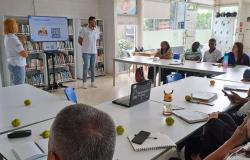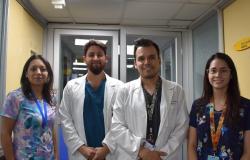According to the Ministry of Health, so far this year two Embera children have died in the National Park. / Oscar Pérez
Photo: Óscar Pérez
Lina María Vitucai was three months old when she died, in the early hours of Sunday, June 9, in the indigenous settlement of the National Park, the product, according to her father Aleison Vitucai, of drowning, when she was left abandoned in a hammock. “I have been separated from my mother for two months. The girl was left alone from 6:00 in the afternoon, while her mother was drunk. “I didn’t know where they were living,” she said.
According to a detailed report from the Ministry of Health, from the time of pregnancy, when the mother was in the La Florida UPI, she underwent prenatal check-ups. On the day of her birth, they had to hospitalize the baby due to low weight. She was later discharged, but she could not receive medical follow-up, according to the District, because the indigenous leaders prevented health personnel from entering.
The day the baby died, it was the same mother who took her to the permanent ambulance, which is located on the outskirts of the National Park. The little girl arrived without vital signs. After informing the Police and the Prosecutor’s Office, the body was transferred to Forensic Medicine and their opinion is awaited to determine the causes of her death.
The death of Lina María once again highlights the failures that both the indigenous people and the authorities have committed in this long chapter of the communities that settled in protest in the capital. To date, with the case of this baby, there are 24 Embera minors who have died since 2021 in Bogotá.
In dialogue with this newspaper, Favio Arias Estévez, spokesperson for more than 120 Embera Katío indigenous families, forcibly displaced from Chocó, recognized some of their failures. For example, they effectively do not allow medical personnel from the Ministry of Health to enter the settlement that he leads.
READ MORE: The latent risk of living near a powder dump: an ignored tragedy
“We have been in the National Park for eight months and they don’t want to hire us as Embera Katío. The secretary doesn’t like us. He just wants to talk to the Embera Chamí leaders, Olga and Jairo.” The serious thing is that while Arias alleges hiring problems, he assures that three children, ages 5, 8 and 14, are sick with fever, vomiting or cough. “I don’t know how we are going to take care of them. I’m worried. “They only depend on an ambulance 24 hours a day.”
Nobody agrees
The situation with children and adolescents settled in the National Park becomes more complex, especially if it is taken into account that they represent 55% of the population. Added to the difficulties for health care is the inefficiency of the administration and the Nation, which, after three years, have not been able to provide a definitive solution to the claims of the indigenous communities.
The situation reached such a point that a councilor had to file a protection action to demand protection of the rights of minors, which the 28th Labor Court of the Bogotá Circuit ruled favorably and gave the ICBF 30 days to follow up on the cases. indigenous minors and verify cases of non-observance of their rights, with the support of other entities that make up the National Family Welfare System.
What is the solution? For the administration, the Embera community, settled in the National Park, must be urgently returned to their territories. To do this, they have a route that, in two months, would allow 83% of the indigenous people, who have expressed their desire to leave, to return to their towns in Chocó. Compared to the 17% who want to stay, there are also plans for them to do so in decent conditions. This was explained by the Secretary of Government, Gustavo Quintero.
“What we have told the National Government, in recent conversations, is the need to strengthen and speed up the work we are doing and give them an offer of return, although it is not a definitive solution, since this Embera population is semi-nomadic, that is , they are going to go and return to the city.”
Although the majority of the Embera approve the plan, for Usiel Villazón Arias, president of the Association of Councils for Colombia, it represents security challenges for the State, since in a department like Chocó there is a high presence of armed groups such as the ELN. “150 homes are also needed, so that they can return, and for the Victims Unit to accompany us for a year with productive projects. And above all, benefit those who are there, because, otherwise, they would return to Bogotá.”
On the other hand, for the 17% of families who want to stay in the city, the outlook is not clear. Although the District says it has a route to serve them, they do not know where they are going to settle them. Although this decision corresponds to the National Government, the truth is that, according to the SAE, for a year they have been offering urban and rural properties to the Mayor’s Office of Bogotá and the Victims Unit, but as of March 2024 there was no formal request. “The conversation about finding places in Cundinamarca, for example, continues,” responded the Government Secretary.
For now, the situation with the Embera in Bogotá does not seem to have a clear outlook. The lack of a unified spokesperson and the differences between the District and the Nation do not allow for a quick solution. And while adults continue looking for paths, children continue to assume consequences of a life they never asked for.
For more news from the capital and Cundinamarca, visit the Bogotá section of The viewer.






